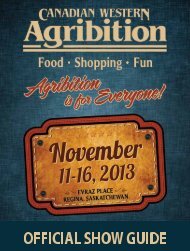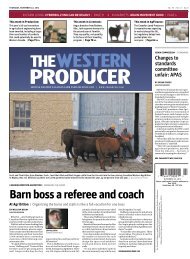You also want an ePaper? Increase the reach of your titles
YUMPU automatically turns print PDFs into web optimized ePapers that Google loves.
LIVESTOCK<br />
THE WESTERN PRODUCER | WWW.PRODUCER.COM | DECEMBER 13 , 2012<br />
COW EVALUATION | UDDER, TEATS<br />
Examination of udders, teats will help decide retention value<br />
ANIMAL HEALTH<br />
ROY LEWIS, DVM<br />
<strong>The</strong>re are many things to evaluate<br />
when selecting a cow. It’s<br />
particularly important to<br />
examine for udder and teat conformation.<br />
Many cows are culled later in life<br />
because of bad teats.<br />
Calves of a cow with bad teats may<br />
have a hard time sucking and getting<br />
much needed colostrum. Persuading<br />
a calf to suck on the big coke bottle<br />
teats can take a lot of individual<br />
attention in the spring calving rush<br />
when labour is at a premium.<br />
Look at the developing udder for<br />
signs of abnormally large or small<br />
teats when selecting heifer replacements<br />
in the spring. <strong>The</strong> teats should<br />
be uniformly in a square. You don’t<br />
want extra teats.<br />
This is especially critical in dairy<br />
cattle where milkers are put on four<br />
teats on a twice daily basis. Most<br />
supernumerary (extra) teats are rudimentary<br />
at best and are usually<br />
either between the normal teats or<br />
behind the normal four teats.<br />
I surgically remove a few in show<br />
cattle, but most often they are left.<br />
<strong>The</strong>y can become a problem if they<br />
are large and the calf tries to suck on<br />
them. <strong>The</strong>y are most often blind ending<br />
and rudimentary and the milk<br />
producing gland isn’t attached.<br />
<strong>The</strong> problem is newborn calves can<br />
spend a lot of time trying to get milk<br />
out of them.<br />
Cows are occasionally five quartered,<br />
which doesn’t hurt in a beef<br />
herd but is a definite no-no in a dairy<br />
animal. Most dairies check newborn<br />
calves for that reason.<br />
Some heifer calves deposit a lot of<br />
fat in the udder. This extra fat has<br />
been proven to hurt their future milk<br />
production. <strong>The</strong>y become the good<br />
looking fat healthy cows that produce<br />
scrawny calves because of lack<br />
of milk production.<br />
Lower weaning weights are most<br />
generally a sign of poor milk production<br />
unless there is another medical<br />
reason for the poor weight gains. This<br />
is another good reason for records<br />
and having tags in both cow and calf.<br />
Knowing the birth date of the calf and<br />
its size at weaning helps eliminate<br />
the poor milkers.<br />
Teats on yearlings should be<br />
noticeable but not too large and<br />
evenly placed. Too small or too large<br />
make it difficult for the calf to latch<br />
onto at birth.<br />
Smaller teats also have a smaller<br />
streak canal that requires lots of sucking<br />
to get milk. Calves are not stupid<br />
so will gravitate to sucking on the<br />
teats that milk the easiest.<br />
Teats that are too large are also hard<br />
for the calf to suck on. <strong>The</strong>y have<br />
larger streak canals and will often<br />
leak milk if the teat sphincter is not<br />
tight. <strong>The</strong>se quarters are prone to<br />
mastitis.<br />
<strong>The</strong> teat will either grow larger over<br />
time because it is never milked out or<br />
a chronic mastitis will take hold, rendering<br />
the quarter useless.<br />
<strong>The</strong> good news about chronic mastitis<br />
is the quarter can be dried off<br />
chemically if the cow is not sick.<br />
A veterinarian can advise on treatment,<br />
which involves either copper<br />
sulfate solution or silver nitrate solution<br />
put up the infected quarter. This<br />
sets up chemical inflammation scarring<br />
and drying off of the quarter.<br />
I prefer 12 cc of a one percent silver<br />
nitrate solution infused up the quarter<br />
and then repeated in 10 days.<br />
It is much easier if the cow is in the<br />
process of being weaned and the<br />
other quarters are being dried off<br />
naturally.<br />
<strong>The</strong> cow then freshens next year as<br />
a three teater. Milk production does<br />
not suffer because a three teated cow<br />
will produce almost as much as a four<br />
teated cow.<br />
����������<br />
However, it is best to cull the cow if<br />
two quarters are shot because milk<br />
production is considerably less.<br />
Calves usually avoid these quarters<br />
because the taste of mastitic milk is<br />
not good, and the swelling and<br />
inflammation should alert the producer<br />
to check.<br />
Scarred and blind teats are more<br />
difficult to notice, but there are telltale<br />
signs: either the calf always<br />
seems to be sucking and yet is gaunt<br />
or the cow’s udder is always full.<br />
If in doubt, get the cow into the<br />
maternity pen and strip out the quarters<br />
to see if milk is present.<br />
Not many cows are brought into<br />
maternity pens these days to calve<br />
out because of easy calving, but the<br />
ones that are should be stripped out<br />
to make sure the teats are not<br />
plugged. This makes it much easier<br />
on a calf just getting started, but it<br />
also allows problems to be detected<br />
early. Many calves starve to death<br />
each year or don’t get enough colostrum<br />
because of teat problems.<br />
Heavy milkers develop low slung<br />
bags and/or their suspensory apparatus<br />
becomes stretched in later life.<br />
Teat placement becomes too low,<br />
which makes it difficult for tall calves<br />
to suck. <strong>The</strong>y should be put on the<br />
cull list.<br />
Self suckers or heifers that suck on<br />
their pen mates should also be sold as<br />
slaughter animals.<br />
As well, watch for teat injuries from<br />
91<br />
freezing on cold windy days. Ointments<br />
may be able to prevent serious<br />
mastitis problems or calves getting<br />
kicked as they suck these sore blackened<br />
teats.<br />
We can lower the cull rate for udder<br />
and teat problems later in life by<br />
checking teat and udder conformation<br />
early and not using the undesirables<br />
as replacements. You won’t<br />
eliminate all the problems, but most<br />
can be avoided. Your goal is tight<br />
uddered, soft milkers with good milk<br />
production that have a long productive<br />
life in your herd.<br />
Roy Lewis has a veterinary practice in<br />
Westlock, Alta. and works part time as a<br />
technical services veterinarian with Merck<br />
Animal Health.<br />
��������������<br />
�������<br />
����������<br />
������������������������<br />
��������������������<br />
�������������������������������<br />
������������������������<br />
��������������������<br />
������������������������������<br />
���������������������<br />
�������������<br />
�����������������������<br />
������������������������������������������<br />
��������������������������








